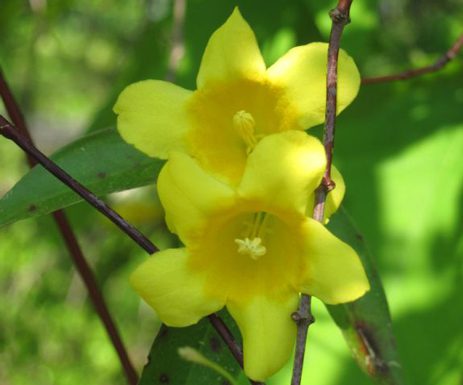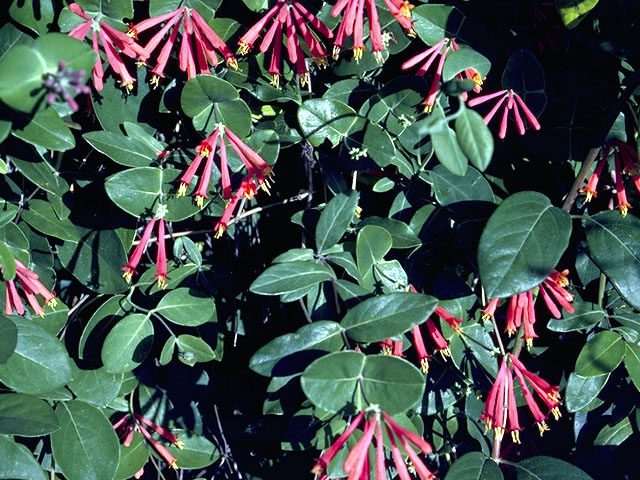Native spring vines

Every spring, I walk along scanning the forest floor for wildflowers. Sometimes I light on an odd arrangement of blossoms. It takes a few seconds for my mind to shift gears. I finally realize the flowers aren’t attached to plants on the ground – they’ve dropped from vines twining through the canopy. Over the next several weeks, we have the opportunity to search high and low for the showy blooms of vines native to the Uwharries.
Carolina jessamine (Gelsemium sempervirens) has already started perfuming the woods. The bright yellow flowers stand out against a backdrop of evergreen, spear-shaped leaves. This species is more common in the coastal plain, but I’ve seen it along sandy creeks and even clay ditches in the forests of the Uwharries.
Coral honeysuckle (Lonicera sempervirens) starts blooming in mid-April. The slender red trumpets are irresistible to returning hummingbirds. The leaves, which vary in shape from oblong to oval, are glossy green on top and glaucous underneath. They appear in pairs along the stem. The ones at the tip of each branch are fused around it, a characteristic that helps me identify this vine even when it’s not in bloom. I tend to see these flowers a little lower in the understory, along forest margins or gaps in the canopy.
By the end of the month, crossvine (Bignonia capreolata) will be in full bloom. It’s capable of climbing to the tops of tall trees and apt to be partially hidden once the canopy leafs out, but it’s hard to miss the large, flashy blooms. Red on the outside and yellow inside, they’re also an important source of nectar for butterflies and hummingbirds. The leaves are semi-evergreen and often turn reddish-purple in winter, making them easy to spot against trunks and bare limbs.
 All three of these native vines make great additions to the garden – tumbling over a retaining wall, rambling over a fence or trellis or scrambling up a tree. I ran across many other uses in Liana Tips or More than Most People Want to Know about Vines, Vine-Like Plants and Other Ramblings. The author, Dr. Gwen Kirtley Perkins, earned a PhD in botany in middle age after raising six children. She completed the manuscript in her early 90s.
All three of these native vines make great additions to the garden – tumbling over a retaining wall, rambling over a fence or trellis or scrambling up a tree. I ran across many other uses in Liana Tips or More than Most People Want to Know about Vines, Vine-Like Plants and Other Ramblings. The author, Dr. Gwen Kirtley Perkins, earned a PhD in botany in middle age after raising six children. She completed the manuscript in her early 90s.
She calls her finished product “a vine-wrapped Brunswick stew.” Quotes from poets, philosophers and the Bible wind their way around the scientific facts, as do family stories and anecdotes from the field. She recommends supplies, equipment and apparel one might want to procure before setting out on a “liana safari.” She also addresses the hazards one might run afoul of in the field – mosquitoes, chiggers, ticks and snakes. Calmly, she advises readers: “Should one be bitten by a poisonous viper…”
Many of her tips come in the form of lively, quirky lists. In the one devoted to habitats, the usual suspects are present – swampy woods and stream banks and the like – but she also notes the vines that might occur at “picnic grounds” and “abandoned home sites with tumbled down buildings.”
Perkins knows her folklore. Carolina jessamine can be used to treat sore throats. If you need to purify your blood, you’re advised to seek out coral honeysuckle or crossvine. Other uses go far beyond the realm of medicine. Need an anti-love potion? Try bittersweet. According to her list, there’s a vine for almost every need – from dyes to dune stabilizers, magic to masonry, and the protection of animals and people. She cautions readers to “use all gently.”
She also includes a section on floriography, a system that allowed straight-laced Victorians to express their emotions through flowers. This spring, present your one-and-only with a sprig of coral honeysuckle. Thanks to Gwen Perkins and her passion for lianas, I now know that it stands for devoted love, affection and fidelity.
Top photograph by Crystal Cockman, Coral honeysuckle photo courtesy of the Lady Bird Johnson Wildflower Center.
Sources:
Liana Tips or More than Most People Want to Know about Vines, Vine-like Plants and Other Ramblings by Gwen Kirtley Perkins will soon be available through Amazon.
Native Shrubs and Woody Vines of the Southeast– Leonard Foote and Samuel Jones, Jr.